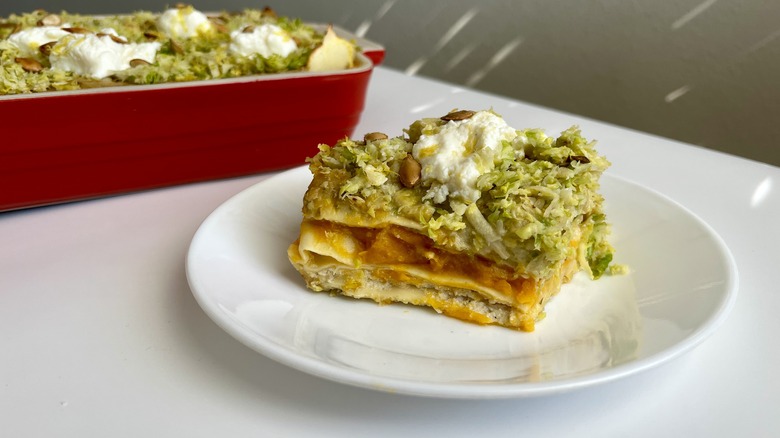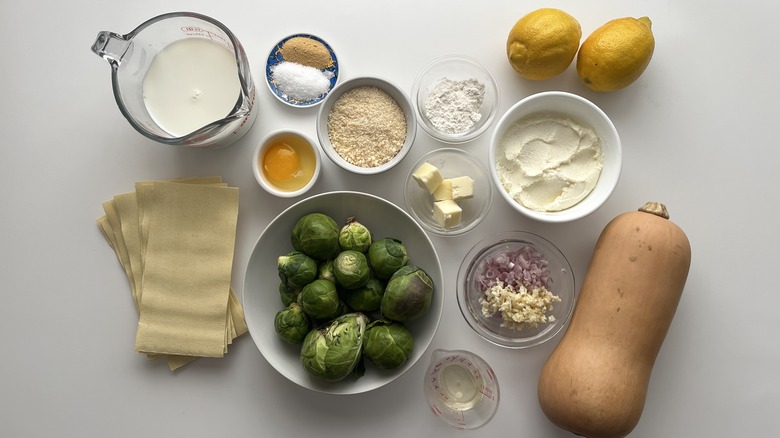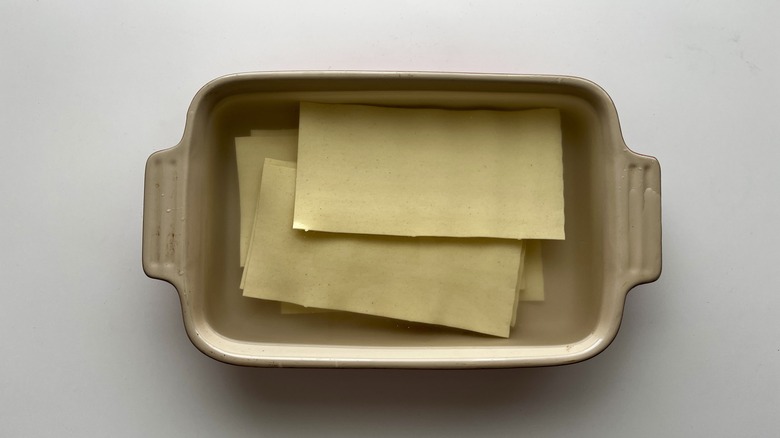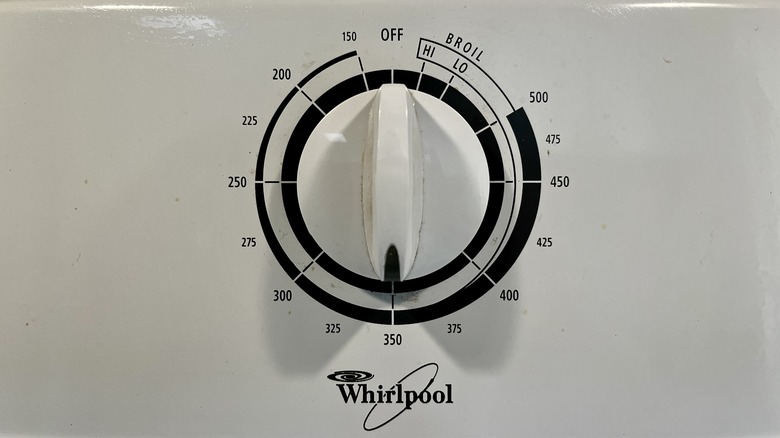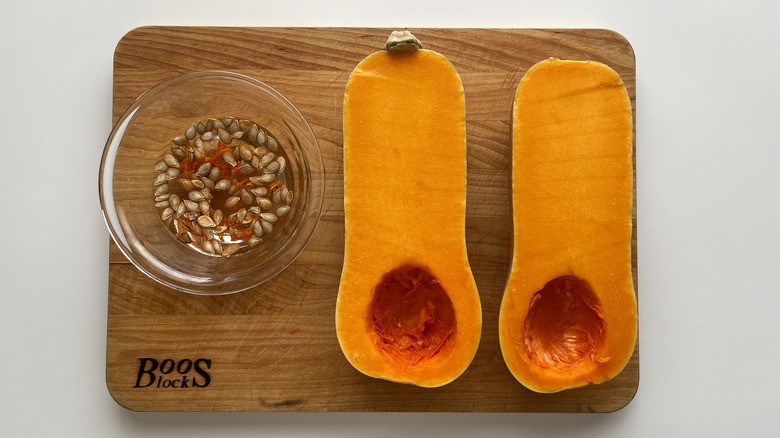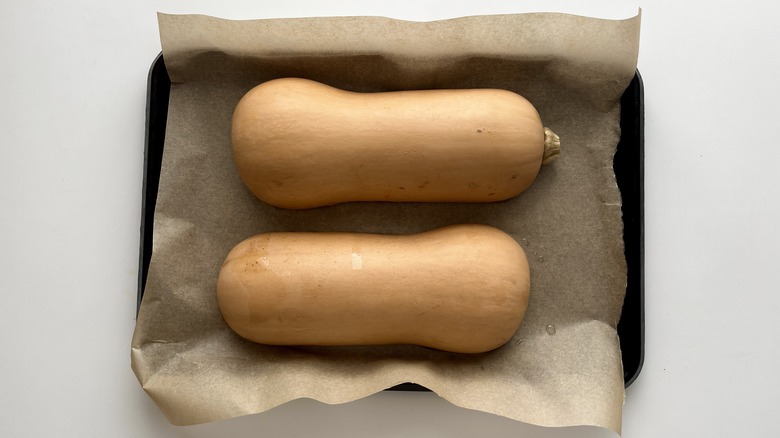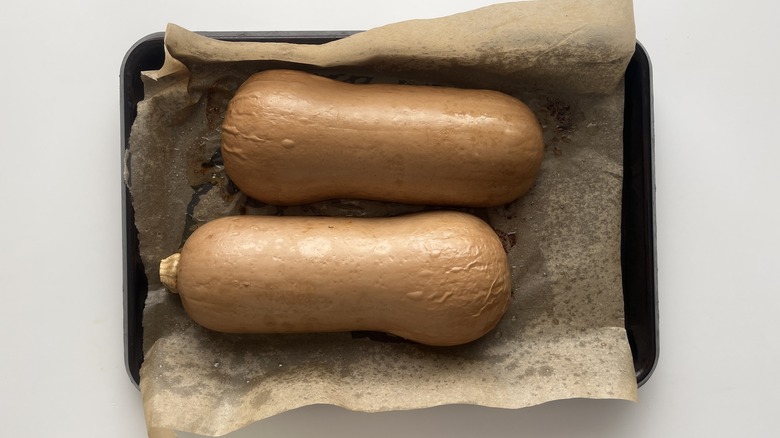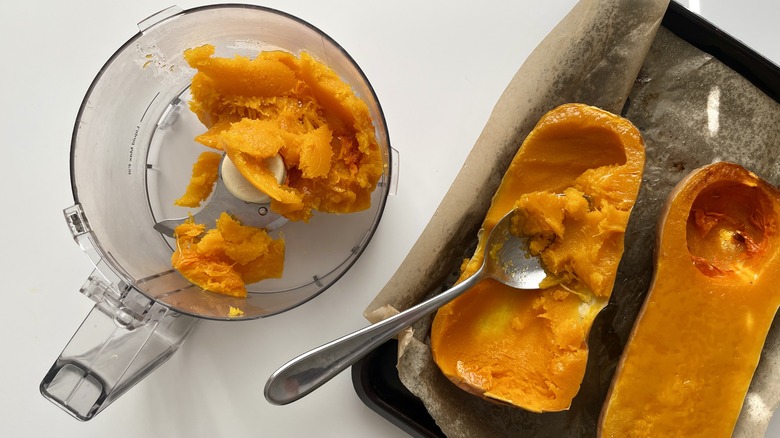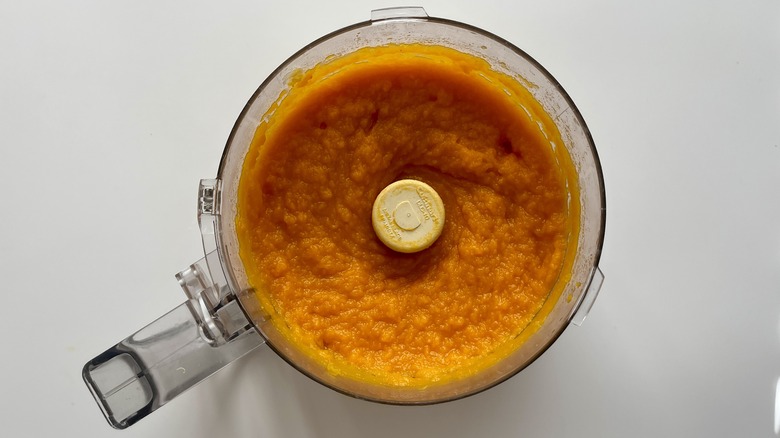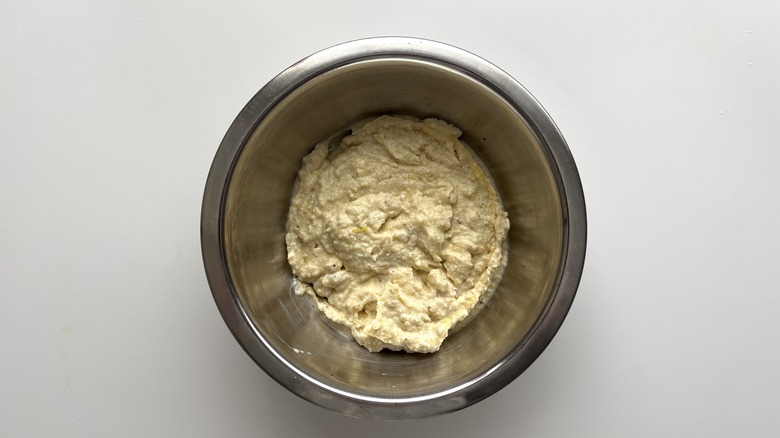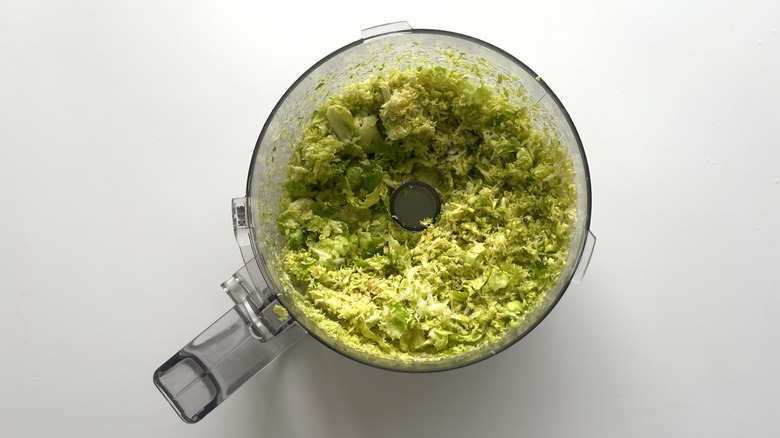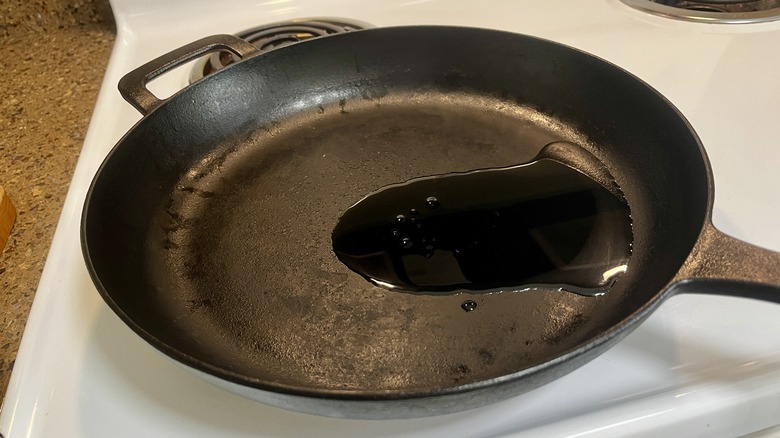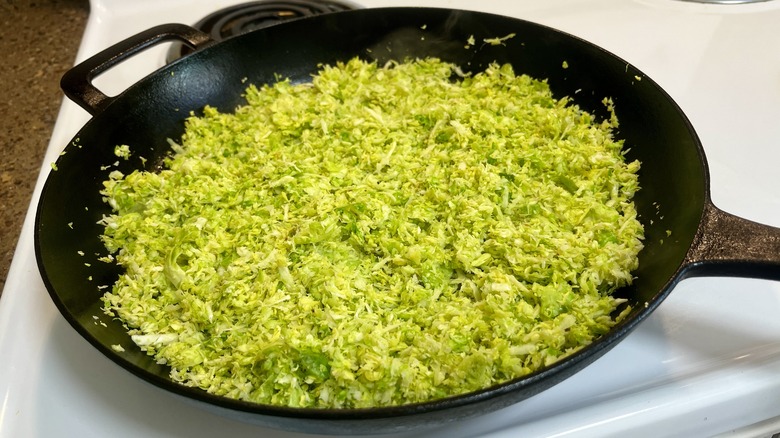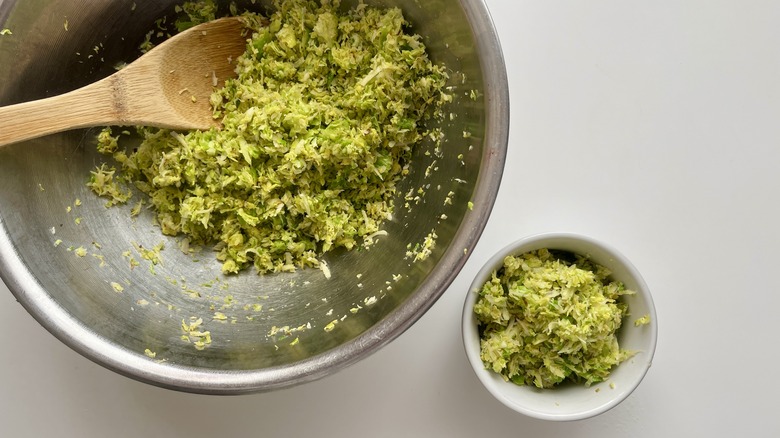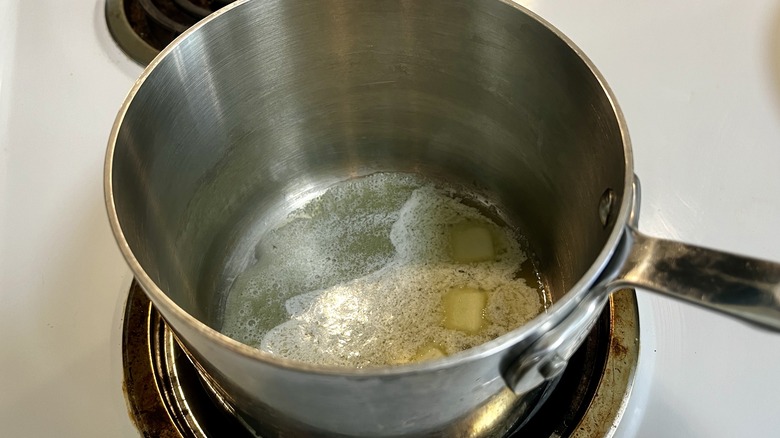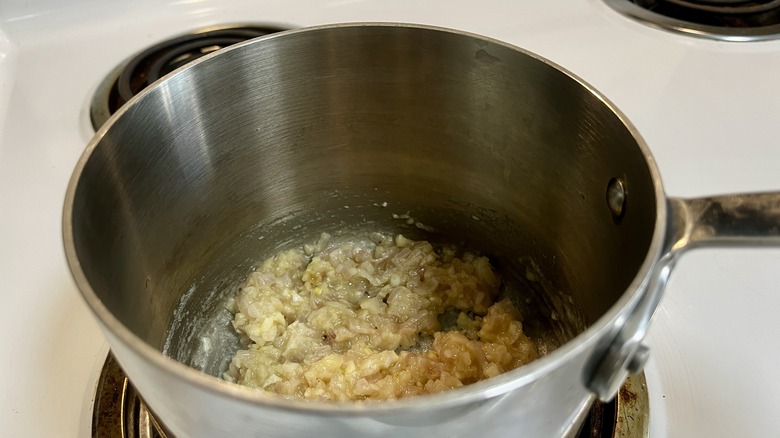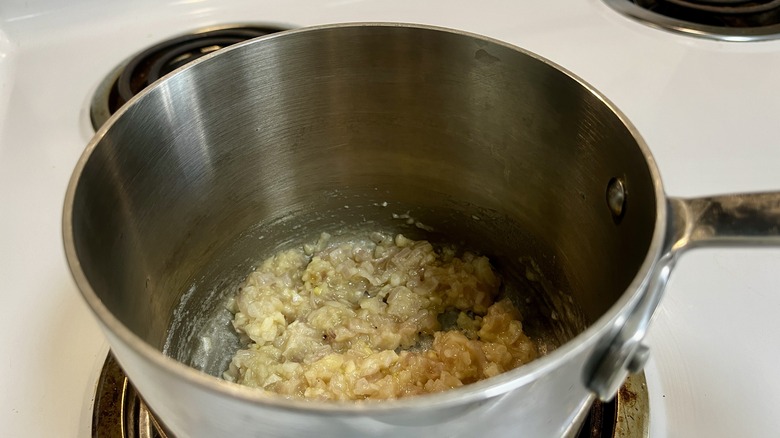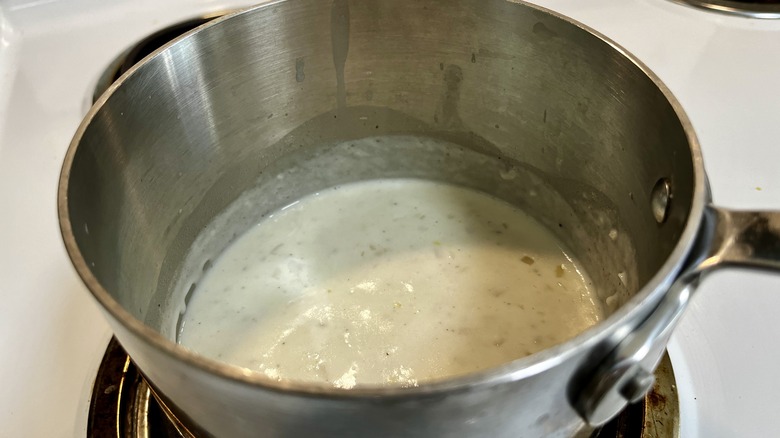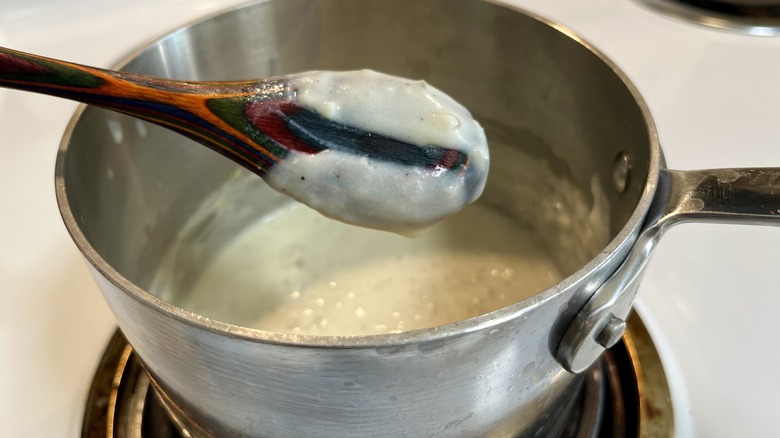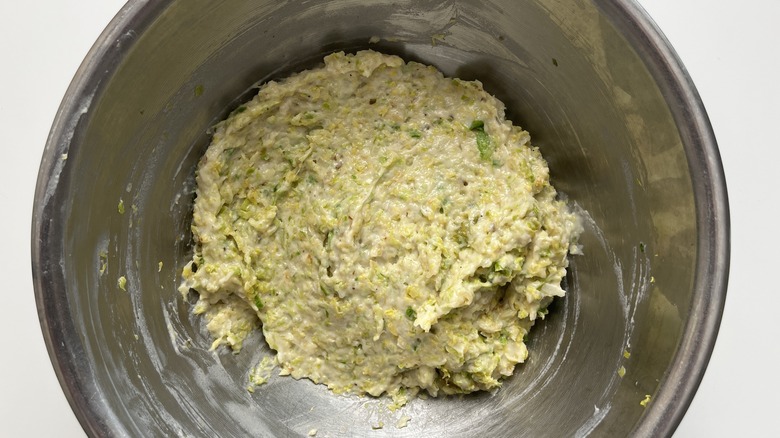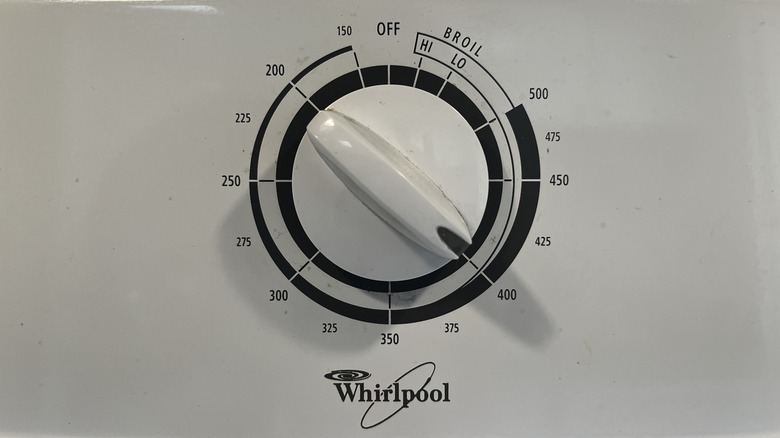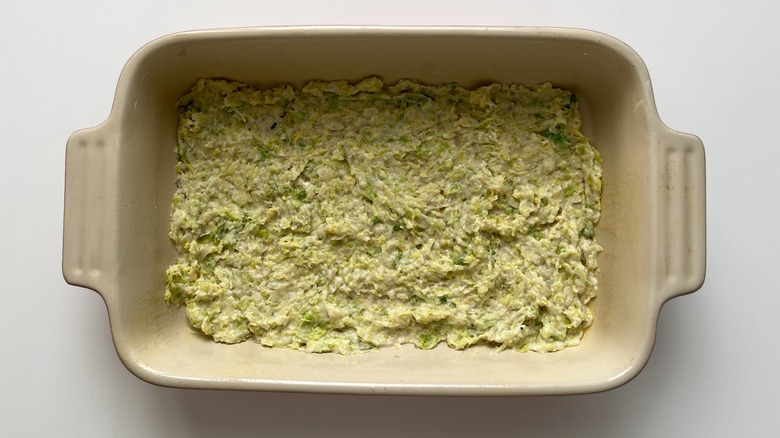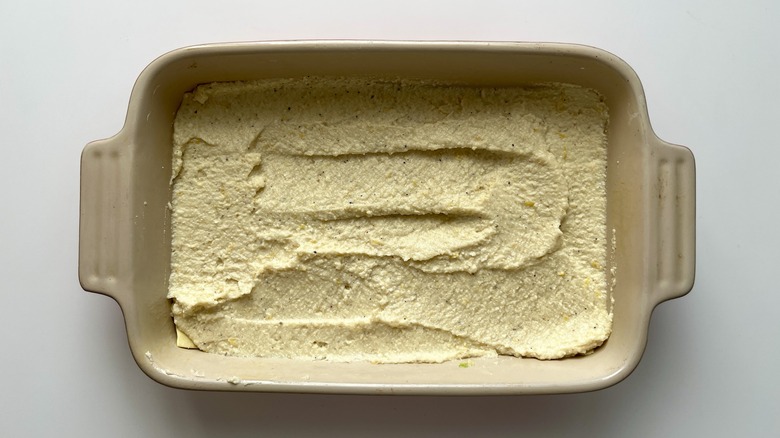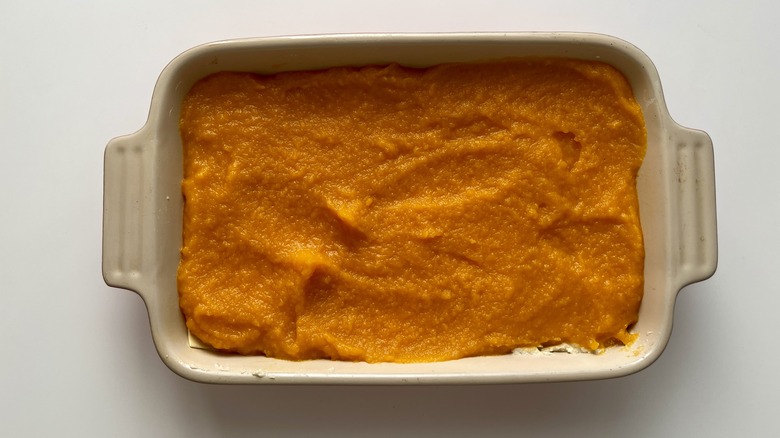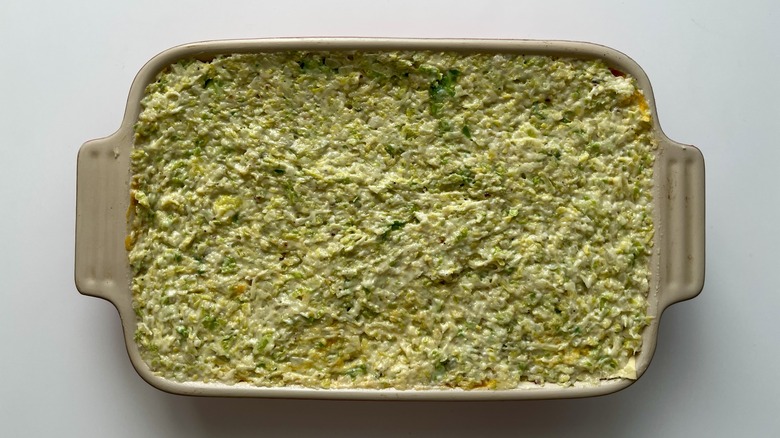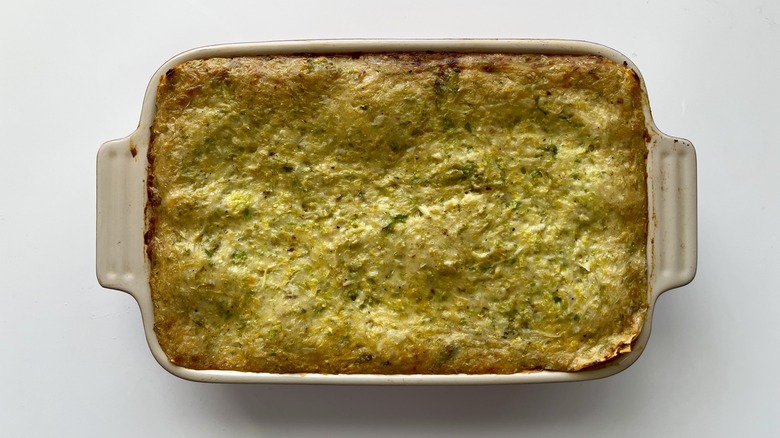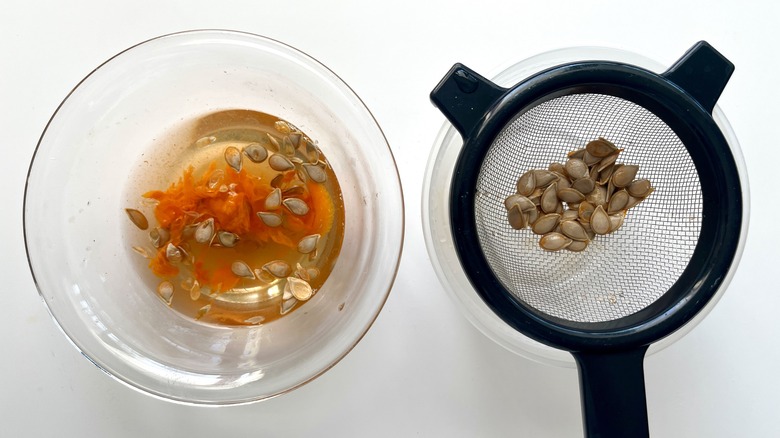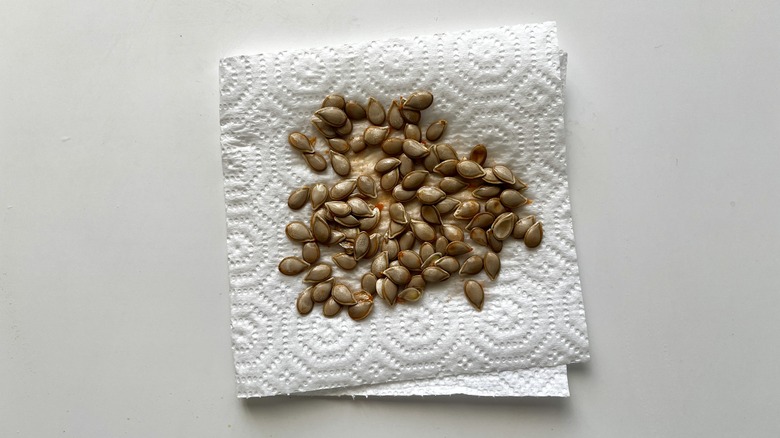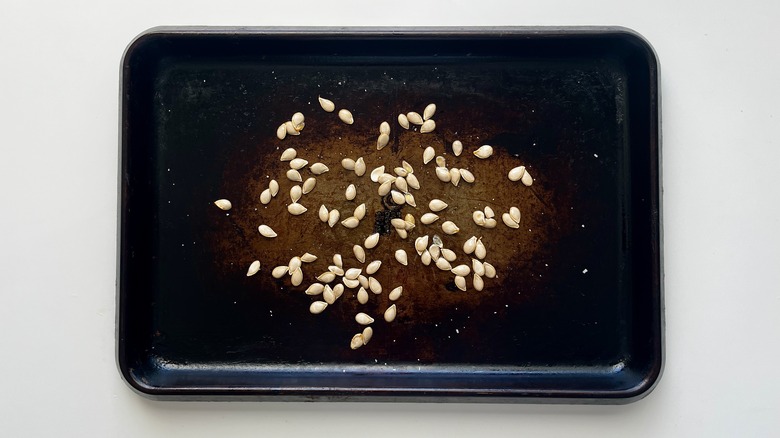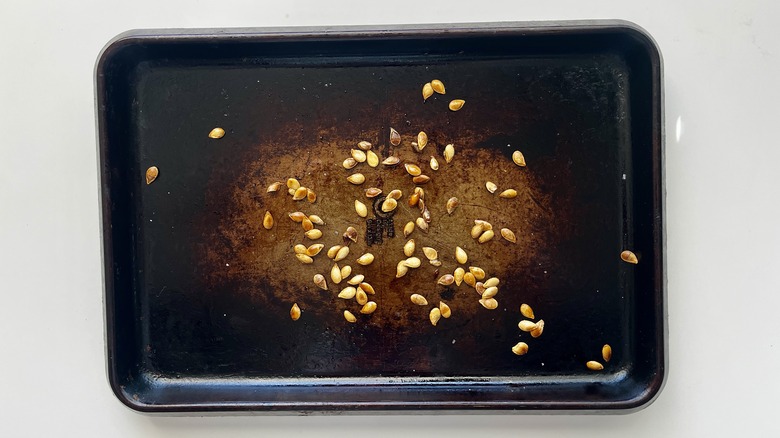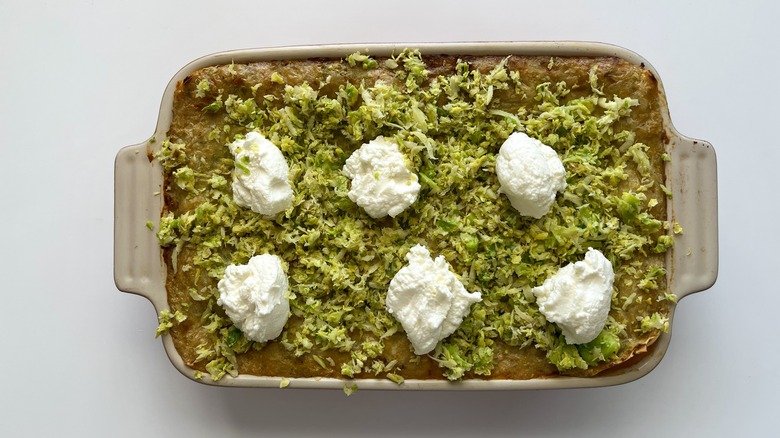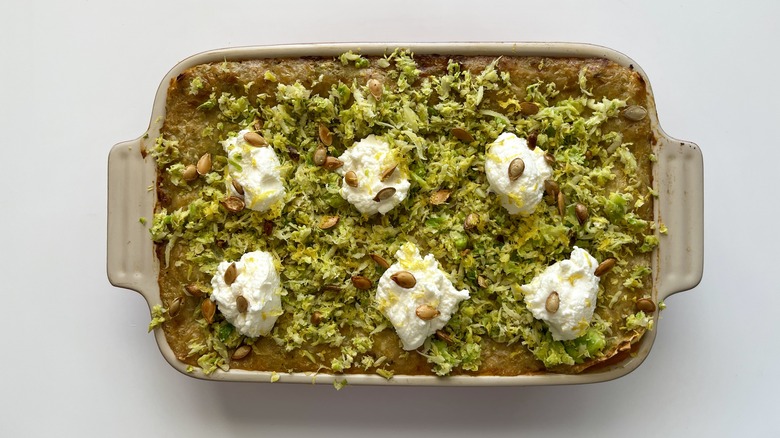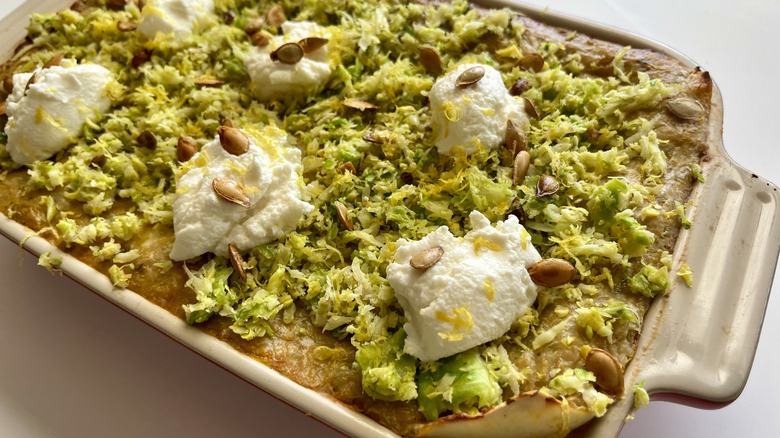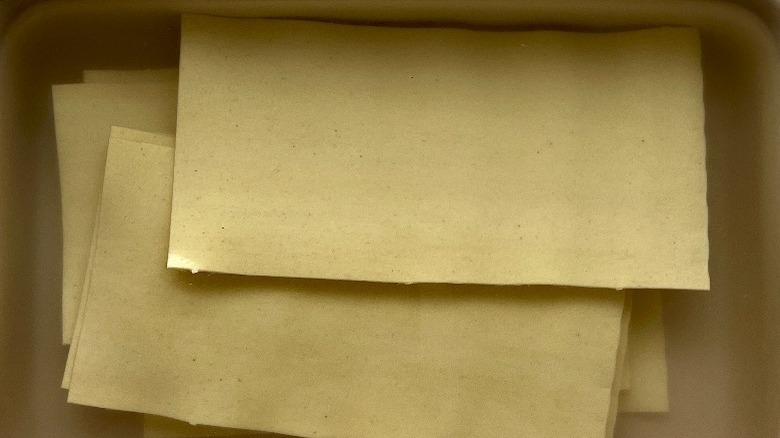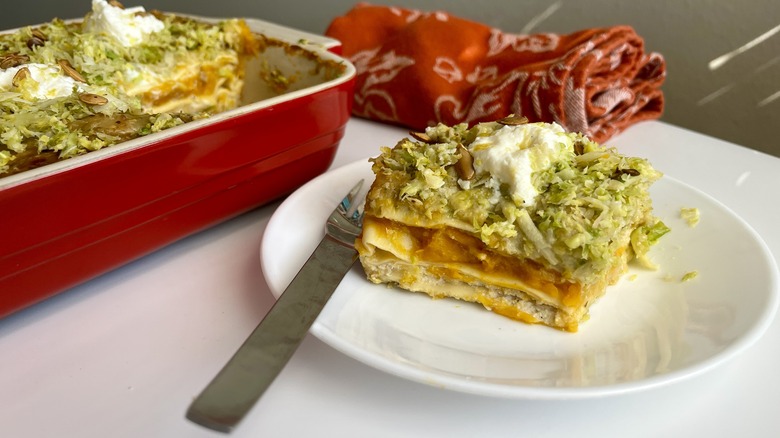Butternut Squash And Brussels Sprout Lasagna Recipe
The classic lasagna we're all familiar with consists of noodles layered with marinara, ricotta or béchamel sauce, mozzarella, and Parmesan. As it turns out, the original lasagna was nothing like this since red sauce wasn't even part of the dish until the 19th century. Developer Tess Le Moing, however, puts her own spin on the recipe by using a couple of unexpected ingredients to elevate her lasagna. As she tells us, it's "a white lasagna with shredded Brussels sprouts stirred into the cheese sauce," and it also includes butternut squash puree.
Not only does this dish make for an interesting twist on the more typical lasagna, but it also has a visual flair all its own. Once you slice into it, you will see what Le Moing describes as "nice clean layers of white and orange," while the outside is a striking green color thanks to an extra layer of shredded Brussels sprouts on top. While this lasagna does take some time and effort to make, it's an excellent entree for a meat-free meal and will allow you to eat several stripes of the produce rainbow in every bite.
Gather the ingredients for the butternut squash and Brussels sprout lasagna
This lasagna is a fairly complex dish with multiple elements, so you'll need a total of 15 different ingredients (many of which are used more than once). You'll need both Brussels sprouts and butternut squash, along with vegetable oil, garlic powder, and salt for cooking, while the béchamel sauce will require a shallot, garlic, flour, and milk. The ricotta layer includes not only the cheese itself but also an egg, some Parmesan, black pepper, and a lemon (both juiced and zested). You're also going to need lasagna noodles, with Le Moing opting for the no-boil kind.
Step 1: Soak the noodles
Place the lasagna noodles in a baking dish and cover with hot tap water. Soak for 5 minutes, moving the noodles occasionally to prevent sticking. Drain and arrange on a kitchen towel.
Step 2: Turn on the oven
Cook the butternut squash: Preheat the oven to 350 F.
Step 3: Slice and deseed the squash
Cut the butternut squash in half lengthwise. Remove the seeds with a spoon, transfer them to a small bowl, and cover with water. Set aside for later.
Step 4: Oil the squash, then put it in a pan
Rub the squash with 1 tablespoon of vegetable oil, then place it face down on a parchment-lined baking sheet.
Step 5: Bake the squash
Bake in the oven until butternut squash is soft all the way through, about 1 hour.
Step 6: Carve out the squash
When cool enough to handle, scoop out the butternut squash flesh with a spoon and place it in a food processor.
Step 7: Puree the squash with garlic and salt
Add garlic powder and 1 teaspoon salt and puree until smooth (you should have about 2 cups). Transfer to a bowl and set aside.
Step 8: Combine the ricotta filling ingredients
Make the ricotta sauce: In a mixing bowl, whisk together the 8 ounces of ricotta, egg, 6 tablespoons of Parmesan, the zest of one lemon, 2 teaspoons lemon juice, 1 teaspoon salt, and ¼ teaspoon pepper. Set aside.
Step 9: Shred the Brussels sprouts
Cook the Brussels sprouts: Shred the Brussels sprouts in a food processor using the grater attachment.
Step 10: Heat the cooking oil
Heat vegetable oil in a large, non-stick skillet over medium heat.
Step 11: Fry the shredded sprouts
Add the shredded Brussels sprouts and cook, stirring occasionally, until bright green and some are lightly browned, about 5 minutes.
Step 12: Season the Brussels sprouts
Transfer cooked Brussels sprouts to a large bowl and stir in 1 teaspoon salt and the remaining 2 teaspoons of lemon juice. Reserve ¾ cup of the Brussels sprouts mix for garnish.
Step 13: Melt the butter
Make the béchamel: Melt butter in a small saucepan over medium heat.
Step 14: Fry the shallots and garlic
Add the shallots and garlic. Cook, stirring frequently, until translucent, about 3 minutes.
Step 15: Stir in the flour
Add flour and cook, stirring constantly, for about 1 ½ minutes.
Step 16: Mix in the milk
Gradually whisk in milk. Bring the mixture to a boil over medium-high heat, then whisk in ¼ teaspoon salt and ⅛ teaspoon pepper.
Step 17: Simmer the sauce
Reduce heat to low and simmer for 10 minutes, occasionally whisking, until thick but still pourable or when a finger run through the back of the spoon comes out clean.
Step 18: Stir the sauce into the sprouts
Whisk in the remaining 6 tablespoons Parmesan, then transfer the sauce to the bowl with the larger portion of the Brussels sprouts mixture and combine.
Step 19: Heat up the oven
Assemble the lasagna: Preheat the oven to 400 F.
Step 20: Put some of the sprout sauce into a pan
Spray a 10.5 x 7.5-inch pan with cooking spray. Using a rubber spatula, spread ½ cup of the Brussels sprout sauce on the bottom of the pan.
Step 21: Add a layer of noodles and ricotta
Cover with a layer of three lasagna sheets, then spread the ricotta mixture on top.
Step 22: Add more noodles and the squash puree
Cover with another three sheets of pasta and spread on butternut squash puree.
Step 23: Finish assembling
Finish by laying the remaining pasta sheets and using the rest of the Brussels sprout béchamel sauce for the top layer.
Step 24: Bake the lasagna
Bake the lasagna at 400 F for 30 minutes.
Step 25: Rinse the squash seeds
Meanwhile, separate the butternut squash seeds from the flesh. Transfer to a fine mesh strainer and rinse with fresh water.
Step 26: Dry the squash seeds
Place seeds on a dish towel or paper towel and pat dry.
Step 27: Oil and salt the squash seeds
Transfer the seeds to a small sheet pan and toss with the remaining 1 teaspoon of oil and a pinch of salt.
Step 28: Cook the squash seeds
Spread evenly and roast in the same oven as the lasagna, stirring halfway through, until the seeds are lightly browned, about 5–10 minutes.
Step 29: Garnish the baked lasagna
Remove the lasagna from the oven and sprinkle with reserved Brussels sprouts, then dollop with the remaining ricotta.
Step 30: Sprinkle on seeds
Sprinkle over roasted butternut squash seeds and the zest of 1 lemon.
Step 31: Cool and serve
Let rest for 20 minutes, and serve.
Why do you pre-soak the noodles for the butternut squash and Brussels sprout lasagna?
Le Moing opts to use no-boil noodles to make her lasagna to save time and effort, but she does add the step of pre-soaking them before assembling the dish. As she explains, "It's difficult to tell just how much liquid no-boil lasagna noodles are going to absorb," and if they absorb too much, she cautions that "sauces can end up dry by the time the lasagna is finished baking."
Soaking the noodles, however, is Le Moing's way of ensuring that her lasagna stays saucy. The 15-minute soak allows the noodles to hydrate. This, she says, "prevents them from soaking up too much more liquid as they bake later on." It does tack on a few more minutes to the prep time, but while you're soaking the noodles, you can get on with prepping the squash and Brussels sprouts or mixing up the ricotta filling.
How can I save time making the butternut squash and Brussels sprout lasagna?
Aside from multi-tasking as you make the lasagna, there are a few more ways you can shave off a little prep time. For one thing, Le Moing suggests, "to cut time on making the puree, buy frozen butternut squash cubes." All you'll need to do is thaw and puree them, although you won't have the squash seeds to garnish the top. Still, you can always substitute store-bought pepitas for a similar effect. You could also use béchamel from a jar if need be –- it might not be quite as good as homemade, but the lasagna will still taste great
While it might not save time, you can also split the prep time between two days by stopping after step 23 of the recipe (the assembly stage), then covering the lasagna and refrigerating it for up to 5 days. "To bake from the refrigerator," says Le Moing, "cover the lasagna tightly with foil and bake it in a preheated, 400 F oven." After the first 10 minutes, take the foil off, then bake it for about 30 more minutes (40 minutes in all). It's done when the top is browned and the cheese is bubbling.
Butternut Squash and Brussels Sprout Lasagna Recipe
This one-of-a-kind lasagna offers several unique elements, from its Brussels sprouts béchamel to its topping of toasted butternut squash seeds.
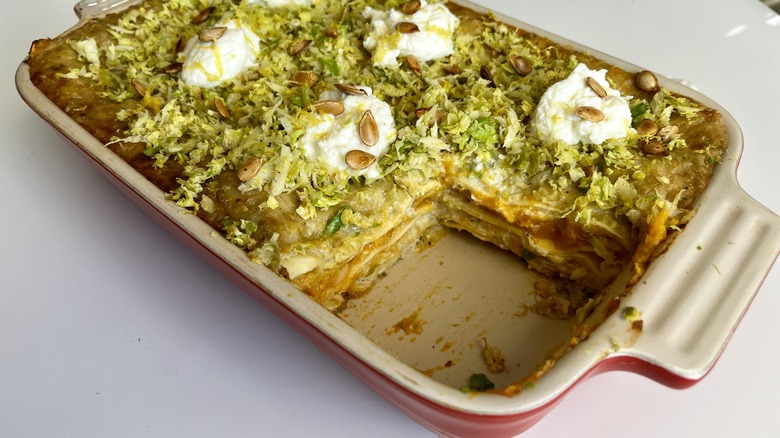
Ingredients
- For the butternut squash
- 1 pound butternut squash
- 1 tablespoon + 1 teaspoon vegetable oil, divided
- 1 teaspoon garlic powder
- 1 teaspoon kosher salt
- For the ricotta spread
- 8 ounces part-skim ricotta cheese
- 1 egg
- 6 tablespoons grated Parmesan cheese
- 1 lemon, zested
- 2 teaspoons lemon juice
- 1 teaspoon kosher salt
- ¼ teaspoon black pepper
- For the Brussels sprouts
- 12 ounces Brussels sprouts, ends trimmed and dark outer leaves removed
- 1 teaspoon kosher salt
- 1 tablespoon vegetable oil
- 2 teaspoons lemon juice
- For the béchamel
- 2 tablespoons salted butter
- 1 medium shallot, minced (about ¼ cup)
- 2 garlic cloves, minced (about 1 tablespoon)
- 2 tablespoons all-purpose flour
- 1 ½ cups whole milk
- ¼ teaspoons kosher salt
- ⅛ teaspoon black pepper
- 6 tablespoons grated Parmesan
- For assembling and finishing the lasagna
- 9 no-boil lasagna noodles
- 1 lemon, zested
- 3 ounces part-skim ricotta cheese
Directions
- Place the lasagna noodles in a baking dish and cover with hot tap water. Soak for 5 minutes, moving the noodles occasionally to prevent sticking. Drain and arrange on a kitchen towel.
- Cook the butternut squash: Preheat the oven to 350 F.
- Cut the butternut squash in half lengthwise. Remove the seeds with a spoon, transfer them to a small bowl, and cover with water. Set aside for later.
- Rub the squash with 1 tablespoon of vegetable oil, then place it face down on a parchment-lined baking sheet.
- Bake in the oven until butternut squash is soft all the way through, about 1 hour.
- When cool enough to handle, scoop out the butternut squash flesh with a spoon and place it in a food processor.
- Add garlic powder and 1 teaspoon salt and puree until smooth (you should have about 2 cups). Transfer to a bowl and set aside.
- Make the ricotta sauce: In a mixing bowl, whisk together the 8 ounces of ricotta, egg, 6 tablespoons of Parmesan, the zest of one lemon, 2 teaspoons lemon juice, 1 teaspoon salt, and ¼ teaspoon pepper. Set aside.
- Cook the Brussels sprouts: Shred the Brussels sprouts in a food processor using the grater attachment.
- Heat vegetable oil in a large, non-stick skillet over medium heat.
- Add the shredded Brussels sprouts and cook, stirring occasionally, until bright green and some are lightly browned, about 5 minutes.
- Transfer cooked Brussels sprouts to a large bowl and stir in 1 teaspoon salt and the remaining 2 teaspoons of lemon juice. Reserve ¾ cup of the Brussels sprouts mix for garnish.
- Make the béchamel: Melt butter in a small saucepan over medium heat.
- Add the shallots and garlic. Cook, stirring frequently, until translucent, about 3 minutes.
- Add flour and cook, stirring constantly, for about 1 ½ minutes.
- Gradually whisk in milk. Bring the mixture to a boil over medium-high heat, then whisk in ¼ teaspoon salt and ⅛ teaspoon pepper.
- Reduce heat to low and simmer for 10 minutes, occasionally whisking, until thick but still pourable or when a finger run through the back of the spoon comes out clean.
- Whisk in the remaining 6 tablespoons Parmesan, then transfer the sauce to the bowl with the larger portion of the Brussels sprouts mixture and combine.
- Assemble the lasagna: Preheat the oven to 400 F.
- Spray a 10 ½ x 7 ½-inch pan with cooking spray. Using a rubber spatula, spread ½ cup of the Brussels sprout sauce on the bottom of the pan.
- Cover with a layer of three lasagna sheets, then spread the ricotta mixture on top.
- Cover with another three sheets of pasta and spread on butternut squash puree.
- Finish by laying the remaining pasta sheets and using the rest of the Brussels sprout béchamel sauce for the top layer.
- Bake the lasagna at 400 F for 30 minutes.
- Meanwhile, separate the butternut squash seeds from the flesh. Transfer to a fine mesh strainer and rinse with fresh water.
- Place seeds on a dish towel or paper towel and pat dry.
- Transfer the seeds to a small sheet pan and toss with the remaining 1 teaspoon of oil and a pinch of salt.
- Spread evenly and roast in the same oven as the lasagna, stirring halfway through, until the seeds are lightly browned, about 5–10 minutes.
- Remove the lasagna from the oven and sprinkle with reserved Brussels sprouts, then dollop with the remaining ricotta.
- Sprinkle over roasted butternut squash seeds and the zest of 1 lemon.
- Let rest for 20 minutes, and serve.
Nutrition
| Calories per Serving | 505 |
| Total Fat | 22.8 g |
| Saturated Fat | 10.4 g |
| Trans Fat | 0.4 g |
| Cholesterol | 81.0 mg |
| Total Carbohydrates | 56.1 g |
| Dietary Fiber | 6.0 g |
| Total Sugars | 8.5 g |
| Sodium | 840.6 mg |
| Protein | 21.9 g |
